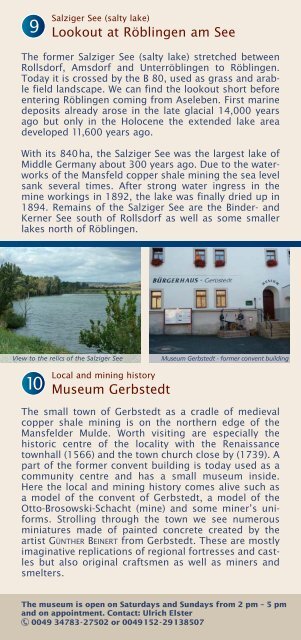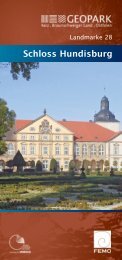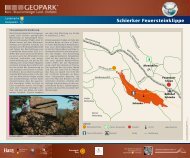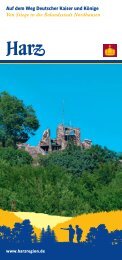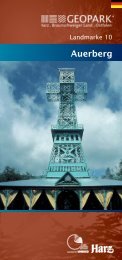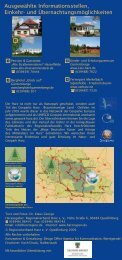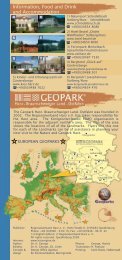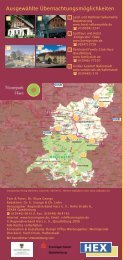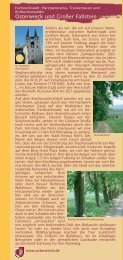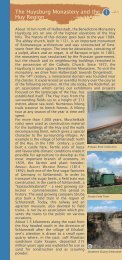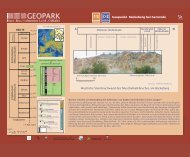Dieses Faltblatt als .pdf - Datei herunterladen (888 kb
Dieses Faltblatt als .pdf - Datei herunterladen (888 kb
Dieses Faltblatt als .pdf - Datei herunterladen (888 kb
You also want an ePaper? Increase the reach of your titles
YUMPU automatically turns print PDFs into web optimized ePapers that Google loves.
9<br />
Salziger See (salty lake)<br />
Lookout at Röblingen am See<br />
The former Salziger See (salty lake) stretched between<br />
Rollsdorf, Amsdorf and Unterröblingen to Röblingen.<br />
Today it is crossed by the B 80, used as grass and arable<br />
field landscape. We can find the lookout short before<br />
entering Röblingen coming from Aseleben. First marine<br />
deposits already arose in the late glacial 14,000 years<br />
ago but only in the Holocene the extended lake area<br />
developed 11,600 years ago.<br />
With its 840 ha, the Salziger See was the largest lake of<br />
Middle Germany about 300 years ago. Due to the waterworks<br />
of the Mansfeld copper shale mining the sea level<br />
sank several times. After strong water ingress in the<br />
mine workings in 1892, the lake was finally dried up in<br />
1894. Remains of the Salziger See are the Binder- and<br />
Kerner See south of Rollsdorf as well as some smaller<br />
lakes north of Röblingen.<br />
View to the relics of the Salziger See Museum Gerbstedt - former convent building<br />
10<br />
Local and mining history<br />
Museum Gerbstedt<br />
The small town of Gerbstedt as a cradle of medieval<br />
copper shale mining is on the northern edge of the<br />
Mansfelder Mulde. Worth visiting are especially the<br />
historic centre of the locality with the Renaissance<br />
townhall (1566) and the town church close by (1739). A<br />
part of the former convent building is today used as a<br />
community centre and has a small museum inside.<br />
Here the local and mining history comes alive such as<br />
a model of the convent of Gerbstedt, a model of the<br />
Otto-Brosowski-Schacht (mine) and some miner’s uniforms.<br />
Strolling through the town we see numerous<br />
miniatures made of painted concrete created by the<br />
artist GÜNTHER BEINERT from Gerbstedt. These are mostly<br />
imaginative replications of regional fortresses and castles<br />
but <strong>als</strong>o original craftsmen as well as miners and<br />
smelters.<br />
The museum is open on Saturdays and Sundays from 2 pm – 5 pm<br />
and on appointment. Contact: Ulrich Elster<br />
0049 34783 - 27502 or 0049 152 - 29 138507


